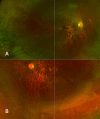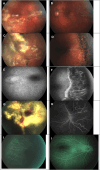Hereditary Vitreoretinopathies: Molecular Diagnosis, Clinical Presentation and Management
- PMID: 39837650
- PMCID: PMC11962705
- DOI: 10.1111/ceo.14494
Hereditary Vitreoretinopathies: Molecular Diagnosis, Clinical Presentation and Management
Abstract
Hereditary vitreoretinopathies (HVRs), also known as hereditary vitreoretinal degenerations comprise a heterogeneous group of inherited disorders of the retina and vitreous, collectively and variably characterised by vitreal abnormalities, such as fibrillary condensations, liquefaction or membranes, as well as peripheral retinal abnormalities, vascular changes in some, an increased risk of retinal detachment and early-onset cataract formation. The pathology often involves the vitreoretinal interface in some, while the major underlying abnormality is vascular in others. Recent advances in molecular diagnosis and identification of the responsible genes and have improved our understanding of the pathogenesis, risks and management of the HVRs. Clinically, HVRs can be classified according to the presence or absence of skeletal or other systemic abnormalities, retinal dysfunction or retinal vascular abnormalities [2]. There are some discrepancies in the literature regarding which diseases are included under the overarching term 'hereditary vitreoretinopathies'. Conditions such as Stickler syndrome, Wagner syndrome and familial exudative vitreoretinopathy are generally included, while others such as autosomal dominant neovascular inflammatory vitreoretinopathy (ADNIV) and autosomal dominant vitreoretinochoroidapathy (ADVIRC) may not. In this review, we will discuss some historical aspects, the molecular pathogenesis, clinical features and management of diseases and syndromes commonly considered as HVRs.
Keywords: Stickler syndrome; familial exudative vitreoretinopathy; hereditary vitreoretinopathy; retinal detachment; vascular disorders.
© 2025 The Author(s). Clinical & Experimental Ophthalmology published by John Wiley & Sons Australia, Ltd on behalf of Royal Australian and New Zealand College of Ophthalmologists.
Conflict of interest statement
The authors declare no conflicts of interest.
Figures





Similar articles
-
Snowflake vitreoretinal degeneration: follow-up of the original family.Ophthalmology. 2003 Dec;110(12):2418-26. doi: 10.1016/S0161-6420(03)00828-5. Ophthalmology. 2003. PMID: 14644728
-
Familial Exudative Vitreoretinopathy: Pathophysiology, Diagnosis, and Management.Asia Pac J Ophthalmol (Phila). 2018 May-Jun;7(3):176-182. doi: 10.22608/APO.201855. Epub 2018 Apr 9. Asia Pac J Ophthalmol (Phila). 2018. PMID: 29633588 Review.
-
[Guidance of Medical Care for Familial Exudative Vitreoretinopathy:Research on Rare and Intractable Diseases, Health and Labour Sciences Research Grants].Nippon Ganka Gakkai Zasshi. 2017 Jun;121(6):487-97. Nippon Ganka Gakkai Zasshi. 2017. PMID: 30088717 Japanese.
-
Familial exudative vitreoretinopathy mimicking persistent hyperplastic primary vitreous.Am J Ophthalmol. 1999 Apr;127(4):469-71. doi: 10.1016/s0002-9394(99)00003-3. Am J Ophthalmol. 1999. PMID: 10218708
-
Clinical features of the congenital vitreoretinopathies.Eye (Lond). 2008 Oct;22(10):1233-42. doi: 10.1038/eye.2008.38. Epub 2008 Feb 29. Eye (Lond). 2008. PMID: 18309337 Review.
Cited by
-
RetiGene, a comprehensive gene atlas for inherited retinal diseases (IRDs).bioRxiv [Preprint]. 2025 Jun 8:2025.06.08.653722. doi: 10.1101/2025.06.08.653722. bioRxiv. 2025. PMID: 40661613 Free PMC article. Preprint.
References
-
- Ding X., “LYaTS. Hereditary Vitreoretinal Degenerations,” in Retina, 7th ed., eds. S. Sadda, Schachat A. P., C. P. Wilkenson, et al. (Philadelphia: Elsevier, 2023), 1019–1042.
-
- Meredith S., “Inherited Vitreo‐Retinopathies,” in The Retina and Its Disorders, eds. Besharse J. C. and Bok D. (San Diego: Elsevier/Academic Press, 2011), 252–262.
-
- Edwards A. O., “Clinical Features of the Congenital Vitreoretinopathies,” Eye 22, no. 10 (2008): 1233–1242. - PubMed
-
- Stickler G. B., Belau P. G., Farrell F. J., et al., “Hereditary Progressive Arthro‐Ophthalmopathy,” Mayo Clinic Proceedings 40 (1965): 433–455. - PubMed
-
- Gartner J., “Photoelastic and Ultrasonic Studies on the Structure and Senile Changes of the Intervertebral Disc and of the Vitreous Body,” Bibliotheca Ophthalmologica 79 (1969): 136–150. - PubMed
Publication types
MeSH terms
LinkOut - more resources
Full Text Sources
Medical

